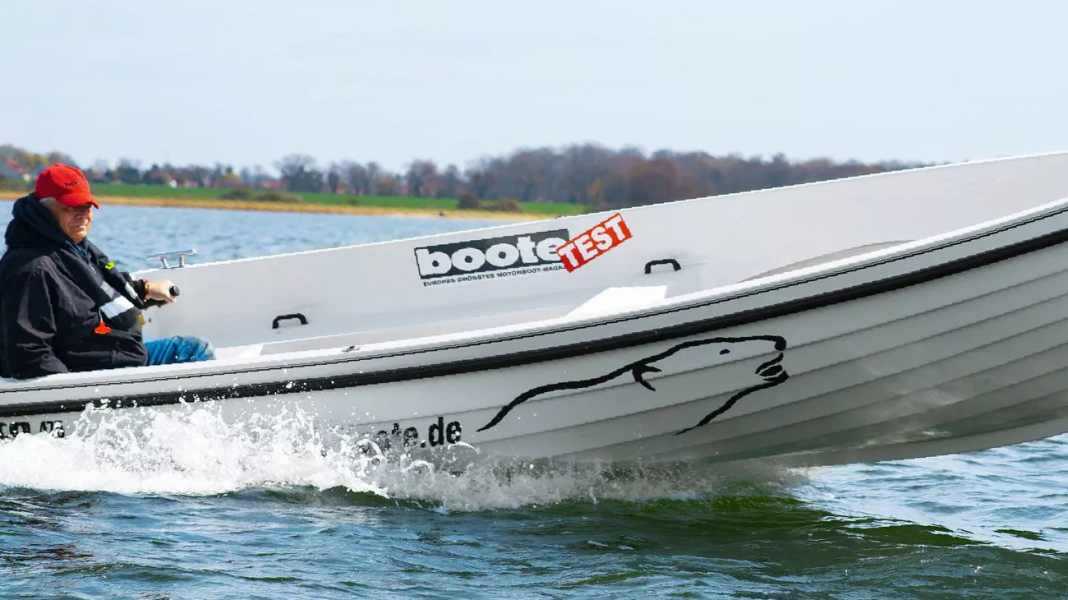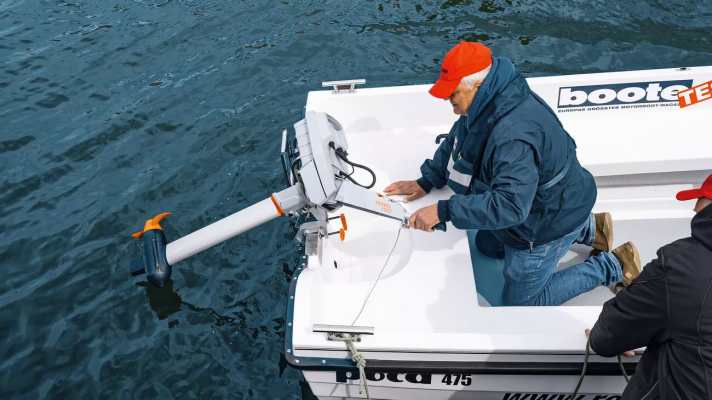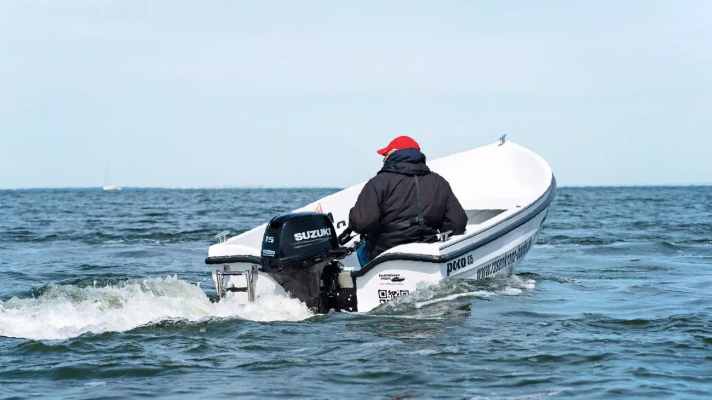
At the beginning of the year, Rosenkranz wrote to me saying that they would like to test boats with us. In the subsequent telephone conversation, it turned out that they would install an electric motor on their second smallest model, the Poca 475 - but could supply not only the electric motor, but also the normal combustion outboard motor. The idea of a comparison was born. Not an entirely fair comparison, however, as the 15 hp Suzuki naturally has considerably more power than the Torqeedo Travel 1103 C, which, according to the manufacturer, replaces a 3 hp combustion engine.
But first to the test boat: the Poca 475 is a fishing boat that is also suitable for swimming trips and discovery tours, and according to the CE sticker it can carry up to four people on board. It is completely open and equipped with a stern, side, bow and rowing bench. The latter is of course a plus in the event of engine problems, as the boat can still be rowed from here using oars in stable dinghies. The benches have no cushions, but are provided with an anti-slip structure. There is plenty of storage space under the benches. With Suzuki motorisation, the tank is located under the rear bench, but is not secured with a strap or similar. The cockpit floor also has an effective anti-slip structure and the hollow spaces underneath are filled with foam, making the boat unsinkable according to the shipyard.
There are plenty of handholds on the inside of the benches. A standard swim ladder makes it easier to get in and out of the water. There are three solid cleats for mooring and an eyelet at the front and two eyelets on the transom for lashing the boat securely to the trailer. A solid rubbing strake provides all-round protection. The boat itself also makes a robust impression and has a protective coating on the inside. The fittings are expertly fastened with through bolts and the transom makes a stable impression. It is reinforced with a stainless steel plate, but there is no eyelet for securing the outboard motor. We drive our two test candidates over the tiller, but if you want more comfort, you can also order a driving position.
The test boat
- Shipyard: Poca/Denmark
- Type: 475
- CE category: C/4 persons
- Hull and deck: Plastic
- Length over everything: 4,75 m
- Width: 1,69 m
- Weight (without outboard motor): 200 kg
- Depth: about 0.64 m
- Tank capacity (with Suzuki): 12 l
- Internal dimensions: 4.32 x 1.45 m
- Interior cockpit side height: 0,59 m
- Freeboard: 0,60 m
- maximum motorisation: Outboard 15 kW (20 hp)
- Price (without motor): 4,535 Euro
- Distribution (test boat): Rosenkranz Boote, Gützkower Landstraße 63, 17489 Greifswald, www.rosenkranz-boote.de

Let's start with the electric motor: due to its low weight, it can be screwed onto the mirror in no time at all. Then attach the battery, plug it in and you're ready to go. Forwards and backwards are controlled using the twist grip. We slowly sail out of the harbour on the Ryck towards Greifswalder Bodden. A breeze with moderate waves comes towards us at the estuary, which we head for from the front. The Poca steers a steady course and rocks easily through the waves. After a few minutes, we turn round and sail with the waves, which also works smoothly and a little faster. We then take the measurements on the calm Ryck at Wieck.
We achieve a maximum speed of 8.0 km/h at 1,100 W. When calculating the range, we also include the obligatory 15 % here. The result is a value of 5.6 km. If we reduce the throttle by just under half (6oo W), the Poca still travels at 6.7 km/h, and you can cover a non-stop distance of 8.6 km. The battery lasts more than twice as far (18.1 km) when travelling at 4.8 km/h at creep speed. These are not huge ranges, but sufficient for one or two routes, especially inland on lakes and perhaps along the coast.
Practical: The speed travelled and the remaining range are shown on a digital display on the tiller. The ride is also relaxed, as the engine runs quietly and the boat drives straight ahead; weight shifts cause it to lean slightly, but this is typical behaviour for such a boat. The same applies to the moderate heeling when someone sits to one side or even leans out.
Motor data electric
- Manufacturer and type: Torqeedo Travel 1103 C
- Design: Electric motor
- Input power: 1.100 W
- tunnelling performance: 540 W
- Comparable petrol outboards (shaft power): 3 PS
- Max. Propeller speed: 1,450 rpm
- Weight (w. battery): 17.3 kg
- Nominal voltage: 29,6 V
- Battery: 915 Wh
- List price: 2,490 Euro
If you turn the tiller fully, the Poca turns both forwards and backwards on the spot. When reversing, it reacts very directly and swivels the nose to the other side within 1 to 2 seconds. Even with increased speed, the boat can be manoeuvred precisely in reverse. At full speed forwards, the test boat also turns its gyros tightly, and when slaloming, the hull swings easily from one side to the other.

About the Suzuki: Slow manoeuvres can be performed in a similar way to the E version, and the displacement speed is also identical. However, if you then turn the throttle grip further to full throttle, the Poca switches from displacement to gliding between around 2,300 rpm and 4,500 rpm. If you are travelling alone in this situation, you will have the rising bow in your field of vision. However, if a second person is sitting in the bow, as was the case during our test drives, the rise is much less pronounced.
Engine data combustion engine
- Manufacturer and type: Suzuki DF15AL
- Design: Four-stroke petrol engine
- Cylinder: 2
- cubic capacity: 327 cc
- Performance: 11 kW (15 hp)
- Speed range: 5,000-6,000 rpm
- Weight: 45 kg
- Fuel: Petrol
- fuel system: Electric petrol injection
- Ignition: electronic
- Cooling: Water/single circle
- Tank capacity: 12 l
- Generator: 12 V, 6 A
- Test propeller: Standard 10"
- List price: 3,410 Euro
Over the speed range from 4,500 rpm to 5,000 rpm (18.5 km/h to 23.5 km/h), the boat/engine combination glides economically. In this situation, only 0.13 litres/km of fuel run through the pipes, giving a range of 76 km plus 15% reserve. On the Greifswalder Bodden we had to deal with a moderate choppy sea, which the hull skips well for the size of the boat. In fast bends, the Poca lays on its side with a strong jerk, but then catches itself and pulls tight circles and brakes itself a little. The tiller is easy to handle, which also applies to the twist throttle, gear lever and quick stop with floating line.
Conclusion
The Poca 475 is a solid fishing boat that is also suitable for exploring. With its electric outboard motor, it is particularly suitable for sheltered waters where combustion engines are prohibited and can be moved across the lake at a comfortable speed. A trip to the coast is of course also possible. However, the range is limited and can be extended with a spare battery. According to Torqeedo, an additional battery costs 939 euros on the Internet. With the Suzuki motor - which, like the electric motor, can be driven without a licence in most areas - much greater ranges can be achieved, especially as a normal 5 or 10-litre reserve canister on board increases the range at no great cost. Another plus point is the planing speed, which allows you to quickly jet to the other shore, for example.

